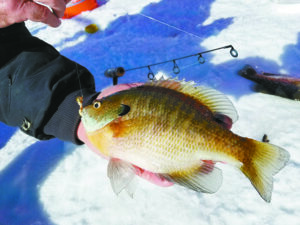James Lindner: Get back to the basics for early-ice panfish – Outdoor News
In our neck of the woods, the open-water fishing season officially has ended. As I’m writing this, my boat has been winterized and is in storage for the foreseeable future.
Ice is firming up fast across Minnesota. Depending on the season, we’re often fishing shortly after Thanksgiving. This year, we’re definitely a bit later. In general, early ice fishing is a sort of boot-strap affair – a spud bar in one hand and small sled with all the basics in the other. I try to keep things to a minimum – an auger, a couple of rods, a small box of baits, and some electronics.
For me, and many other anglers, the primary targets for first ice are crappies and bluegills. Like any fishing situation, the hardest part of catching is actually finding. Thankfully, with panfish, finding them usually leads to a lot of catching in a relatively small area.
MORE ICE FISHING COVERAGE FROM OUTDOOR NEWS:
Ice fishing kicking off in Minnesota as ice slowly thickens; here’s a report from many popular areas
Top new ice fishing tackle, gear for the 2023-24 season
An Adirondack ice fishing sampler: Here are some lakes to target
Where to focus
At first ice, we generally focus on two different locational patterns for panfish – depending on the lake, of course. High-end mapping has truly revolutionized the sport of fishing and is arguably the most beneficial tool for anglers who understand how fish move seasonally.

The primary location for first-ice panfish revolves around vegetation, primarily weed flats. During the fall period, a good portion of the weeds die off. The remaining vertical, green weeds are real magnets for both bluegills and crappies, as well as many other species, including largemouth bass.
Where are the best weed flats, you ask? Well, that really depends on the lake. Everything from main-lake weed flats to shallow bays can be good this time of year. The key is to hunt down the healthy ones. To locate these shallow fish, a camera is a must-have.
Our typical modus operandi involves drilling out an area and checking each hole with an Aqua Vu Micro Revolution 5. Most panfish species are often suspended in or near the remaining stalks. Once we’ve located an area that’s holding panfish, we drill a series of additional holes about 20 to 30 feet apart.
Don’t forget a little deeper water
The secondary location for tracking down early crappies and bluegills exists in deeper water. Look to 20- to 35-foot basin areas, particularly those with large weeds flats adjacent to the deeper holes. These areas will hold panfish of all types, but often draw larger number of crappies.
These fish will typically concentrate in these areas in the late fall to feed on bloodworms or midge larva that exist in the soft, mud-bottom areas. Today’s electronics have made finding these fish far easier than it’s ever been.
Unlike the old days, we can cover a basin area with just a few holes. Essentially, we’re drilling holes every hundred feet or so and relying on our forward-facing sonar units to quickly check an area. Traditional 2D sonar certainly still works, but it takes quite a few more holes to find, and stay on, the fish.
When it comes to presentations, live bait is far from necessary at first ice. Micro spoons, such as the VMC Bull Spoon or Clam Outdoors Pinhead Pro are perfect choices for crappies and bluegills during this timeframe. Hardbaits, such as the Rapala Slab Rap or Rippin’ Rap, are ideal for picking off the more aggressive fish as well.
If downsizing is necessary, it’s hard to top jig and plastic combinations such as the VMC Tungsten Mustache Jig or Wax Tail Jig.
First ice is a magical time of year. Fish are often hungry and gear requirements are minimal. Remember to pack lightly and use common sense. All we need now is ice everywhere.
Source: https://www.outdoornews.com/2023/12/08/james-lindner-get-back-to-the-basics-for-early-ice-panfish/






